Aliyah Bet & Machal Virtual Museum
North American Volunteers In Israel's War of Independence
Pictorial History: Acquiring Arms and Personnel
Threatened with invasion from five Arab nations, Palestinian Jews desperately needed equipment, ammunition and specialized military expertise. They turned to the Diaspora for help. The Jewish and Christian volunteers who answered that call were known as "Machal" (volunteers from abroad).
Some 3,500 men and women from more than 40 different countries volunteered for the Israeli armed forces during the War of Independence. About 1,000 of these came from the United States and Canada. South Africa, with a population of only 125,000 Jews, sent 900 volunteers.
They were all known by the Hebrew acronym "Machal," the acronym for the Hebrew words mitnadvei chutz l'aretz, “Volunteers from Outside Israel.” Most of the American and Canadian Machalniks were World War II veterans; some were Christian. Many provided the expertise the Israelis lacked.
Israeli youth had suffered devastating losses from Arab attacks before and after the departure of the British on May 15, 1948. The Machal volunteers missed the brunt of those first assaults, but when they arrived they provided the additional manpower and expertise to help make Israel the master of its enemies. Perhaps almost as important, they were a symbol to the hard-pressed Israelis that they were not alone, that there was a world beyond their shores that cared about their survival. Killed in the War of Independence were 119 overseas volunteers, 40 of them American and Canadian.
An Army without Weapons
United Nations Resolution 181 on November 29, 1947, created a Jewish state and an Arab state within the Palestinian mandate, but provided no guarantee for the survival of either one. The United States banned the sale of weapons to the Middle East one week later, and most other major powers followed suit. England announced it would leave Palestine on May 15, 1948. Palestinian Jews had to find weapons by that date (or shortly thereafter) or face destruction. The Arab League had publicly rejected Resolution 181, and five surrounding Arab nations, all with well-equipped armies, were prepared to invade as soon as the British left.
The Palestinian Jews had enough manpower to face their enemies. But they had neither the money to buy supplies nor the expertise to use and maintain more complex equipment, even if it could be smuggled through the world embargo. They turned to Jews in the West for funds to buy arms and they turned to Jewish and Christian World War II veterans who could teach them how to utilize the more sophisticated equipment, especially aircraft.
Americans and Canadians Answer the Call
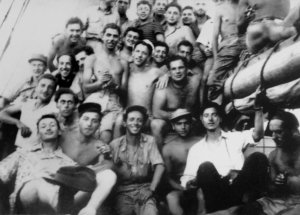
Photo courtesy Dr. Jason Fenton
In the U.S., an organization called Land and Labor for Palestine secretly recruited veterans of World War II to help the Israeli cause. Zionist organizations in Canada did the same. A group from Canada is shown aboard the Marie Annick, on their way to service in the Israeli armed forces.
The volunteers on the right -- from the United States, Canada and England -- had their photograph taken at Tel Aviv’s Dizengoff Circle only two days after their arrival aboard the Pan York and induction into the army. Within ten more days, most of the young men in this photograph would go into actual combat.

Photo courtesy Ralph Lowenstein
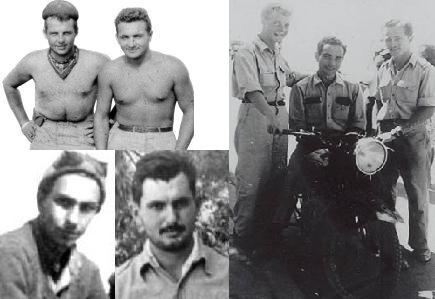
Photos courtesy M. Levinson, E. Kaplansky, J. Fenton
At least three sets of brothers from the U.S. and Canada served as volunteers. In the motorcycle group on an Israeli base are, from left, Montreal natives Dave Kaplansky, 18, Irving Kaplansky, 23, and Eddy Kaplansky, 21. Dave and Eddy were brothers; Irving was a first cousin. • Aboard the Mishmar Haemek on the way to Israel are Bostonians Fred Levinson, 19, left, and Morton Levinson, 18. • The two individual photos show Los Angeles brothers Philip Balkin, 19, left, and his brother Jerry (Tiny) Balkin, 22. Phil Balkin was killed in combat in the Negev on December 27, 1948, just weeks before fighting in the War of Independence ended.
Vidal Sassoon
Vidal Sassoon, 20, right, was a Machalnik from England. He served in a Palmach commando unit in the Negev. In later life, he revolutionized the women’s hair industry, establishing 20 exclusive salons throughout the world and numerous fashion schools and academies.

Vidal Sassoon

Endangered Citizenship
A paragraph in all U.S. passports in 1948 warned that the passport was invalid if used for travel to join a foreign army. Unlike the volunteers from most other nations, Americans risked not only their lives but their citizenship by serving in Israel’s armed forces. Loss of citizenship could be the penalty for Americans swearing allegiance to a “foreign power.” A number of Americans asked for certification that they had not sworn such an oath. This letter was sent to Stanley Klorman, 20, of Los Angeles just before his discharge from the Israeli army. In the end, the threat of loss of citizenship was not enforced.
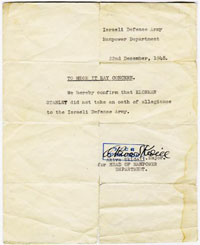
Courtesy Klorman family
The Gator and the B-17
An incident that received front-page treatment for a number of days in 1948 involved a University of Florida graduate named Irvin (Swifty) Schindler, from Miami. Schindler, who had learned to fly while a student at the University of Florida in Gainesville in the late 1930s and flew four-motored aircraft during World War II, attempted to smuggle a surplus B-17 to Israel.
He landed at a military airfield in Canada because of bad weather, and is shown here being arrested by Royal Canadian Mounted Police. Even so, he eluded his captors and flew his plane as far as the Azores, where he was again arrested, this time by Portuguese authorities. He was returned to the U.S. for trial and given a suspended sentence for violating the U.S. Neutrality Act. Israel’s only heavy bombers were three B-17s flown illegally out of a Miami airport in June 1948. Piloted by American, World War II veterans, they played a significant role in defeating Israel’s enemies, with each plane conducting about 50 bombing missions in the six-month period between July 1948 and January 1949.

Associated Press Photo
Jacksonville Pilot
Bill Katz, 27, from Jacksonville, Florida, (shown in U.S. Army Air Corps uniform) piloted one of the three B-17s smuggled out of Miami. During World War II, he had flown 25 bombing missions over Europe, ending the war as a captain. He was named commander of No. 69 “Hammer” Squadron, the bomber force stationed at Ramat David Air Force Base in Israel. He married and made a new life in Israel, later becoming the chief pilot of EL AL Airlines. EL AL ran this ad in the New York Times on October 10, 1962. It shows a photograph of Tillie Katz of Jacksonville, with her son's photo as an El Al pilot next to her. The headline reads, "My son, the pilot." As only a mother can, she extols both her son and the airline he takes care of.
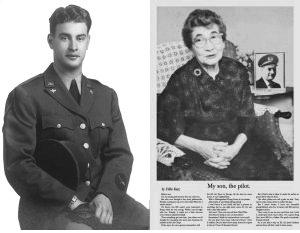
A Halftrack that became a Tank
Unable to purchase tanks because of the arms embargo, Israel bought about 200 World War II surplus personnel carriers to use, it said, as “agricultural tractors.” The American-made halftracks and Israeli-made armored cars became the workhorses of Israel’s two armored battalions.
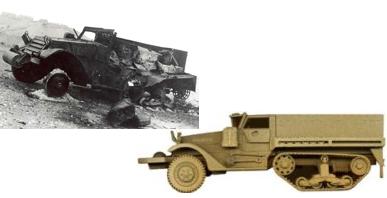
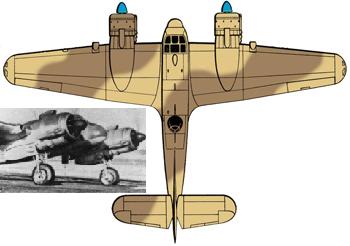
Artifact by Ian Breheny
A Hollywood Ending
Israeli agents found four old Bristol Beaufighters, British-built attack bombers, in England. To thwart the British embargo on arms sales, they set up a dummy film production company to produce a movie about New Zealand Beaufighter pilots during World War II. On the first day of filming, the four planes took off from an English airport, headed to Czechoslovakia, and never returned.
Three Who Paid the Penalty
Hundreds of Americans and Canadians worked beyond the public eye to purchase and deliver military equipment to Israel. In many cases, they risked huge fines and jail terms, since the United States embargo on exporting war material to the Middle East carried severe penalties.
Two Americans who never wore Israeli uniforms, and one who did, stand out. They served heroically and all were fined or imprisoned for their efforts.
One was Brooklyn-born Hank Greenspun, who rose from private to captain in World War II while serving in Gen. George Patton’s Third Army. With his background in military ordnance, Greenspun, 39, took leave from his job at a Las Vegas radio station to examine airplane motors, parts and machine guns in a Hawaii salvage yard. He returned with 42 crates of airplane engines and 16 crates of machine guns and barrels, some of it bought, some of it stolen. U.S. Customs seized the engine parts, but Greenspun literally hijacked a boat and sailed the machine guns to Mexico, whereupon they were transshipped to Israel. Greenspun continued to smuggle other arms and ammunition to Mexico for delivery to Israel. He was fined $10,000 for violating the Neutrality Act and deprived of his civil rights. (He was pardoned many years later.)
Charlie Winters, 38, a Miami businessman, sold Haganah supporters three World War II B-17s that he had been using to haul fruit and vegetables from Puerto Rico. These would become the only three heavy bombers in the Israeli Air Force. Winters, a Christian, was convicted of violating the Neutrality Act and sentenced to 18 months in a federal prison. He was the only American actually jailed for defying the embargo. After his death in 1984, his remains were transferred to Israel for burial in the ancient Templars Cemetery in Jerusalem.
The towering figure in the effort to smuggle aircraft to Israel – and perhaps the greatest unsung hero in the War of Independence -- was Al Schwimmer, 30, from Bridgeport, Connecticut. Schwimmer, an experienced flight engineer with Trans World Airlines (TWA) and a licensed pilot, became the major domo of aircraft purchase and weapons delivery for Israel. He directed the transfer of some 13 surplus heavy transport planes to Panama, and thence to Israel. He organized the Air Transport Command that carried arms from Czechoslovakia to Israel. He also recruited many of the pilots, engineers, and mechanics for the new air force. Schwimmer became second-in-command of the new Israeli Air Force, with the rank of lieutenant-colonel. Upon returning to the U.S., he was fined $10,000 for violating the U.S. Neutrality Act and lost his civil rights for life. (He was pardoned 50 years later by President Clinton.) He returned to Israel in 1950 to establish and head Israel Aircraft Industries, which would become Israel’s largest company, with 20,000 employees.
David Ben-Gurion described Al Schwimmer’s activities in 1947-1948 as the Diaspora’s single most important contribution to the survival of Israel.
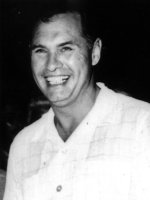
Hank Greenspun
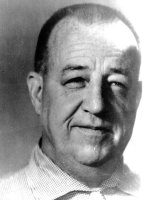
Charlie Winters

Schwimmer with Ben-Gurion

 Home
Home